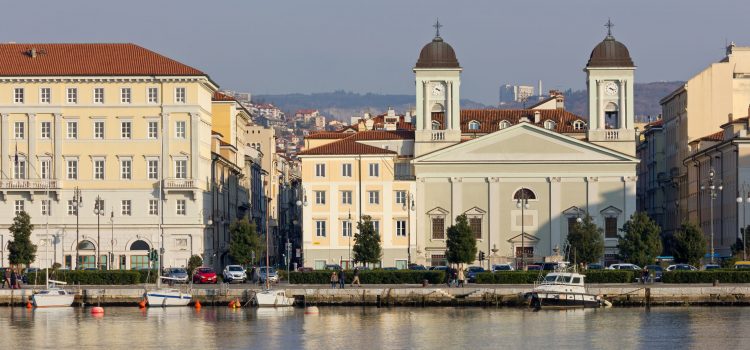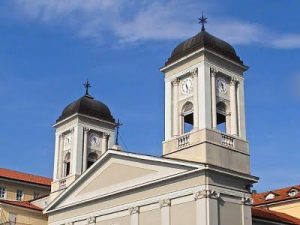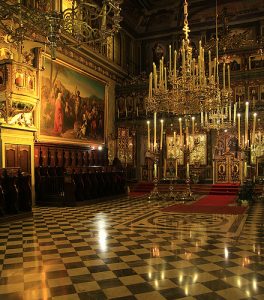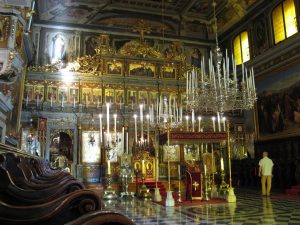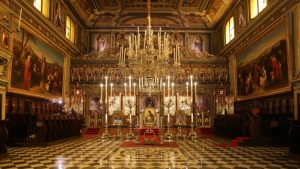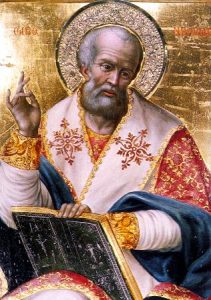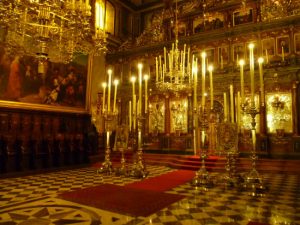La magnifica iconostasi divide il presbiterio riservato ai celebranti dalla navata a cui accedono i fedeli.La navata con pavimento di marmo a riquadri bianchi e neri è ingentilita da scanni lungo le pareti. Al centro, tra grandi candelabri, sono affiancate l’icona di San Nicolò e, sull’apposito proskinitirion, l’icona che ricorda la festività in atto.La grande tela raffigurante Cristo in gloria circondato da angeli ricopre tutto il soffitto piano ed è ricca di effetti prospettici con balaustre e scorci di architettura classicheggiante.Tale dipinto (olio su tela) può essere attribuito ad un anonimo pittore greco educato principalmente all’Accademia ionica di Panaghiotis Doxaras (1662-1729) non privo d’influssi della scuola veneta. Tra le finestre immagini degli Evangelisti e degli Apostoli.Sulle pareti laterali due grandi quadri del piranese Cesare dell’Acqua (1821) raffiguranti a sinistra la Predicazione di Giovanni Battista e a destra Cristo tra i fanciulli; il quadro sopra la porta di destra raffigura la Filoxenia, ovvero L’ospitalità di Abramo verso gli angeli, ed è attribuibile alla stessa mano della tela del soffitto. L’iconostasi nei luoghi di culto ortodossi separa il presbiterio dai fedeli: diffonde un senso di ricchezza con il luccichio dell’argento che incornicia e copre le icone che la compongono.Fulcro del luogo sacro, è opera di ignoto intagliatore e risente di stile impero nella struttura generale e di stile barocco nella decorazione.
Simile a quella che era stata eseguita dal Treppan (1794) per il vecchio San Spiridione, essa si eleva su tre registri e si apre sul presbiterio con tre porte dette “regali”: al centro dei battenti di legno, intagliato e dorato, sono inseriti degli ovali dipinti a tempera.Sul coronamento, realizzato a girali e volute, trova luogo il Crocifisso tra la Madonna e San Giovanni, decorato con simboli deli evangelisti realizzato dalla stessa mano che ha decorato le porte “regali”.Le tre tele del registro superiore raffigurano Gesù nel Getsemani, la Deposizione e il Noli me tangere.Nel registro di mezzo l’iconostasi reca ventuno icone a tempera su tavola con fondo oro che raffigurano la Vita di Gesù, dall’Annunciazione all’Ascensione, realizzate dal pittore greco Giovanni Trigonis; nel corso dell’anno queste vengono esposte sul proskinitirion alla venerazione dei fedeli.Il Trigonis, originario delle isole ionie, operò a Trieste dal 1786 al 1833 e vi aprì una scuola di pittura poi affidata al figlio.Notevoli le otto icone dispotiche del registro basso, realizzate dallo stesso Trigonis: sei delle splendide coperture d’argento lavorate a sbalzo sono dovute all’artista greco Costantino Ghertzos operante a Venezia e datate 1839-1856. Queste icone ricordano, nell’ordine da sinistra, San Giorgio, San Spiridione, San Nicolò, la Madonna col Bambino, Cristo in Trono, la Trinità, San Giovanni Precursore e Santa Caterina.Le coperture delle due icone ai lati estremi, quelle di San Giorgio e di Santa Caterina, sono dovute la prima ad oreficeria russa del 1848, e la seconda ad un artista triestino.
Al momento della consacrazione della chiesa (1787), la comunità greca di Gerusalemme fece dono di otto piccole icone che riproducono in misura ridotta, le immagini delle grandi icone qui descritte, le coperture d’argento delle quali lasciano intravedere solo pochi particolari. Tali icone, che fanno mostra di se su eleganti mensole sottostanti, sono attribuibili ad una mano che ha assimilato motivi tardobarocchi pur operando in area palestinese.Gli altari del presbiterio, visibili dalle porte regie dell’Iconostasi, sono inseriti in piccole absidi.In quella centrale appaiono affreschi con i Santi Giovanni, Giacomo, Basilio e Atanasio che fanno da contorno alla SS. Trinità ed alla Madonna; nelle absidi laterali a sinistra la Natività e a destra la Deposizione dalla Croce.Il pulpito ligneo, riccamente decorato da stucchi dorati, riporta quattro pannelli a tempera raffiguranti i quattro evangelisti mentre sulla porticina di accesso è raffigurante il Christos Basileus, tutti opera del Trigonis. Il pulpito è coronato da un fregio austriaco i segno di gratitudine per la concessione, ricevuta dai regnati della casa d’Austria, alla costruzione della nuova chiesa.Le balconate, poste sopra la porta d’ingresso e parzialmente sui lati, sono sostenute da mensole e colonne; quella inferiore, costituiva a suo tempo il gineceo, è decorata da dieci pannelli in olio su tela, attribuibili dalla stessa mano che ha realizzato il registro superiore dell’iconostasi.
Raffigurano scene bibliche quali, nell’ordine, Il Sacrificio di Isacco, L’Entrata di Gesù in Gerusalemme, La Creazione di Eva, La Cacciata dei mercanti dal Tempio e Il Sogno di Giacobbe.La balconata superiore, che costituisce il palco per i cantori, è decorata con tele che raffigurano La morte di Abele, Giona che fugge dalla balena e La Famiglia di Noè dopo il diluvio.Durante le festività della Settimana Santa e della Pasqua hanno luogo celebrazioni particolarmente sentite: la rappresentazione del Santo Sepolcro avviene tramite l’Epitafios, scultura lignea della fine ‘700 attribuibile ad una bottega artigiana locale.Sospeso su 10 colonnine, il baldacchino è sormontato da tre cupole: nella sua parte alta quattordici tavole policrome descrivono la passione e morte di Cristo, dalla preghiera nell’orto alla deposizione dalla croce.

